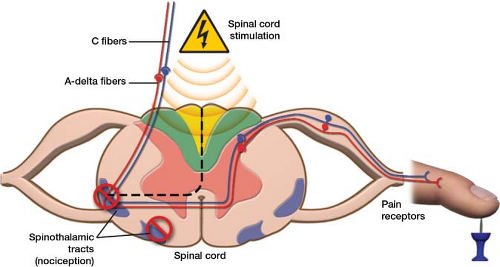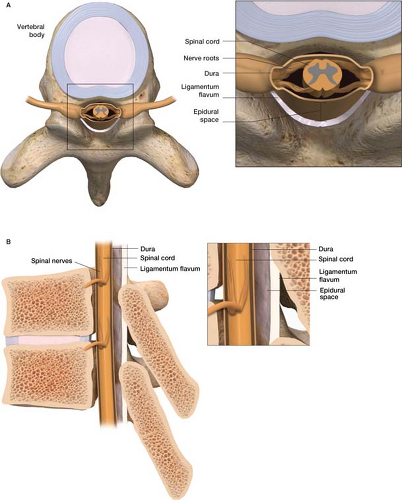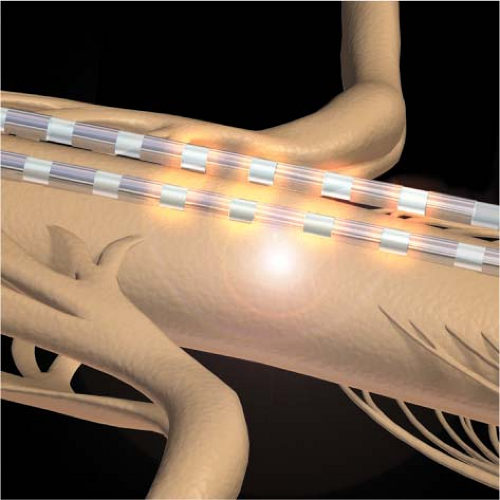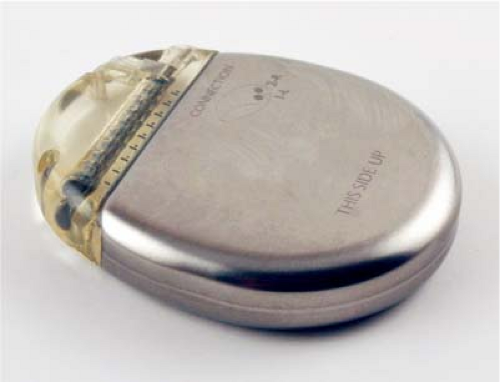Spinal Cord Stimulation
Since 15 BC electricity has been used to treat pain. Ancient Roman physicians used the torpedo fish, also known as electric ray, to treat headaches and gout. Over time the advancement of using controlled electricity to treat pain has led to the spinal cord stimulator. The development of the spinal cord stimulator centered around the gate control theory of pain published by Wall and Melzack in 1965. It holds that pain transmission to the brain occurs through the “gate,” in the substantia gelatinosa in the dorsal aspect of the spinal cord (Fig. 29-1). At the “gate” both large myelinated fibers (pressure, touch, and vibration) and thin pain transmitting fibers, (unmyelinated C fibers and lightly myelinated A-delta fibers) synapse
(Fig. 29-2). Through the “gate” only one message can pass at a time and the passage of large myelinated fibers are preferred over thin fibers.1 A spinal cord stimulator activates these large myelinated fibers (mechanoreceptors) as well as polysynaptic interneurons (PSINs) effectively closing the “gate” on the smaller pain fibers (Fig. 29-3). The PSINs when activated fire back on the dorsal horn blocking pain receptors from synapsing. The greater the activity of larger myelinated fibers (mechanoreceptors) and PSINs there is to the activity of thin pain fibers, the less pain sensation is felt. The goal is to activate the specific set of large myelinated fibers (mechanoreceptors) and PSINs that overlap the areas of pain. It is possible to do this without causing discomfort or motor effects. Think about it this way. If a bee stings you a common response is to start rubbing the area where you feel the piercing sharp pain. Essentially what you are doing is activating mechanoreceptors by creating a sense of vibration over the area, which overrides the painful sensation trying to get through the “gate.”
(Fig. 29-2). Through the “gate” only one message can pass at a time and the passage of large myelinated fibers are preferred over thin fibers.1 A spinal cord stimulator activates these large myelinated fibers (mechanoreceptors) as well as polysynaptic interneurons (PSINs) effectively closing the “gate” on the smaller pain fibers (Fig. 29-3). The PSINs when activated fire back on the dorsal horn blocking pain receptors from synapsing. The greater the activity of larger myelinated fibers (mechanoreceptors) and PSINs there is to the activity of thin pain fibers, the less pain sensation is felt. The goal is to activate the specific set of large myelinated fibers (mechanoreceptors) and PSINs that overlap the areas of pain. It is possible to do this without causing discomfort or motor effects. Think about it this way. If a bee stings you a common response is to start rubbing the area where you feel the piercing sharp pain. Essentially what you are doing is activating mechanoreceptors by creating a sense of vibration over the area, which overrides the painful sensation trying to get through the “gate.”
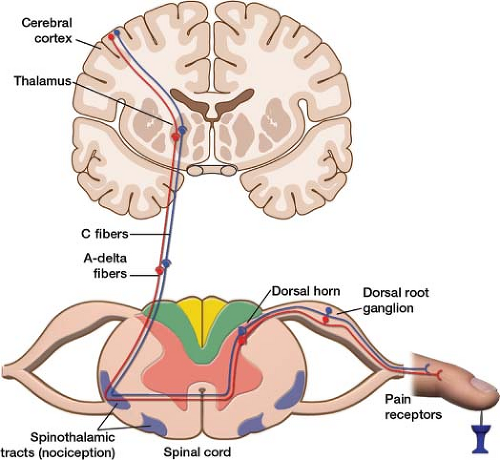 Figure 29-1 Pain transmitted from a body part to the dorsal aspect of the spinal cord up to the brain for interpretation. |
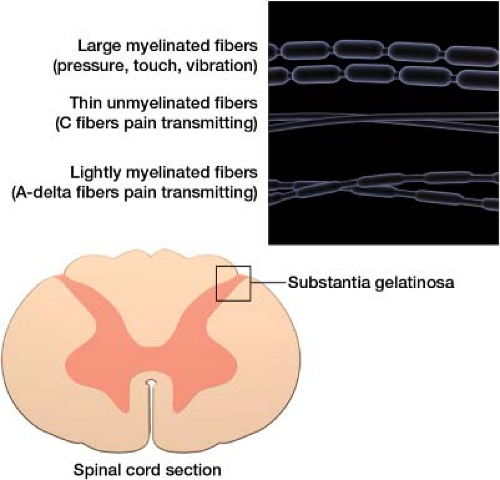 Figure 29-2 Multiple sensory impulses synapse at the substantia gelatinosa in the dorsal horn of the spinal cord. |
This is the main theory, but the exact mechanism of spinal cord stimulation is not completely understood. Spinal cord stimulation may alter pain as well by modulating the descending pathways. After ascending pathways send pain signals to the brain, descending pathways are activated to complete the loop and alter pain transmission as it enters the spinal cord. This effect may occur through GABAergic interneurons. Spinal cord stimulation is also known to inhibit sympathetic outflow. This leads to an increase in blood flow and a reduction of oxygen demand in ischemic tissue. Interestingly cerebrospinal fluid levels of vascular endothelial growth factor which is thought to modulate neuronal transmission and promote chronic neuropathic pain are reduced by spinal cord stimulation in patients with failed back surgery syndrome.
The flexible, catheter-style leads of the spinal cord stimulator never physically touch the spinal cord. Instead they enter the posterior epidural space. The epidural space is the outermost space in the spinal canal, lying outside the dura mater inside the surrounding vertebrae (Fig. 29-4). It is the same location in which a
catheter is placed to deliver anesthesia to the expectant mother during childbirth. Controlled electric current is driven to the back of the spinal cord to stimulate the large myelinated fibers of the dorsal horn (Fig. 29-5).
catheter is placed to deliver anesthesia to the expectant mother during childbirth. Controlled electric current is driven to the back of the spinal cord to stimulate the large myelinated fibers of the dorsal horn (Fig. 29-5).
An analogy I give to my patients to help them understand the purpose of the spinal cord stimulator is that the heart runs on electricity and when it malfunctions a pacemaker is used to correct it. The nervous system runs on electricity as well and when it malfunctions, it too can be corrected using a pacemaker. Like the heart pacemaker the spinal cord stimulator system consists of two catheter-style leads and a battery that sits under the skin. In fact, many of the same companies that manufacture the heart pacemaker also make the pacemaker for pain. The leads are cylindrical polyurethane flexible catheters with multiple evenly spaced electrode contacts. The battery is currently about the size of a silver dollar (Fig. 29-6).
When to use
Much of the original work implementing spinal cord stimulation was done by spine surgeons who were not seeing positive results with repeat surgery for patients who did not respond to the first operation. The first spinal cord stimulator was placed in 1967 for failed back surgery syndrome—when a patient has spine surgery and continues to have significant pain despite proper surgical correction. Other indications beyond failed back surgery syndrome include: Complex regional pain syndrome (formerly known as reflex sympathetic dystrophy),2 cervical and lumbar radiculopathy, arachnoiditis, peripheral neuropathy, and intractable pain from postherpetic neuralgia. It is primarily used for neuropathic pain, not nociceptive pain (pain from bone, joints, organs). Spinal cord stimulation is more effective in treating extremity (in a limb) than axial pain, thus for people with back and leg pain, leg pain is more responsive to stimulation than back pain. In Europe, spinal cord stimulation is often used to treat ischemic pain arising from peripheral vascular disease in the
lower extremities. The sympathetic block created by the stimulation allows for parasympathetic-induced vasodilation. It has been shown that spinal cord stimulation improves perfusion pressure and red blood cell flow velocity, and may improve the possibility for limb salvage (Fig. 29-7).3 Spinal cord stimulation is a tertiary treatment for pain and should be entertained when less invasive measures have been tried first.
lower extremities. The sympathetic block created by the stimulation allows for parasympathetic-induced vasodilation. It has been shown that spinal cord stimulation improves perfusion pressure and red blood cell flow velocity, and may improve the possibility for limb salvage (Fig. 29-7).3 Spinal cord stimulation is a tertiary treatment for pain and should be entertained when less invasive measures have been tried first.
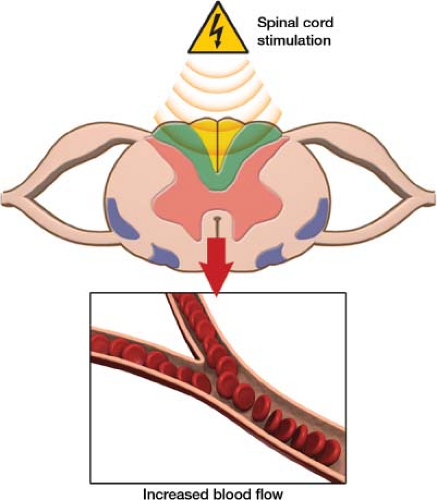 Figure 29-7 Spinal cord stimulation increasing blood flow into a limb by creating a sympathetic block allowing a parasympathetic-induced vasodilation. |
Before implantation of a permanent system, patients first undergo a spinal cord stimulation trial to determine if full implantation is appropriate. The trial involves placement of flexible catheter-type leads into the posterior epidural space under fluoroscopic guidance (Fig. 29-8). This requires no knife, because an introducer needle provides access to the epidural space. A local anesthetic such as lidocaine is necessary to ensure patient comfort.
The practitioner simply feeds the leads into the posterior epidural space via the introducer needle, adjusting them under fluoroscopic guidance until the patient verbally reports that the stimulation covers the area of pain and there is no aberrant stimulation. A stitch or a StayFIX® pad anchors the leads to the skin. After the practitioner connects the leads to a small connection wire, it is necessary to dress the area in standard sterile fashion, usually with a 4 × 4 bandage and Tegaderm. The connection wire plugs into an outside generator that sits in a pouch that the patient wears. A handheld device (Fig. 29-9) controls stimulation features, which include turning the device on and off, varying intensity, and choosing from multiple stimulation programs. The patient then goes home shortly after the procedure.
The practitioner simply feeds the leads into the posterior epidural space via the introducer needle, adjusting them under fluoroscopic guidance until the patient verbally reports that the stimulation covers the area of pain and there is no aberrant stimulation. A stitch or a StayFIX® pad anchors the leads to the skin. After the practitioner connects the leads to a small connection wire, it is necessary to dress the area in standard sterile fashion, usually with a 4 × 4 bandage and Tegaderm. The connection wire plugs into an outside generator that sits in a pouch that the patient wears. A handheld device (Fig. 29-9) controls stimulation features, which include turning the device on and off, varying intensity, and choosing from multiple stimulation programs. The patient then goes home shortly after the procedure.

Full access? Get Clinical Tree


